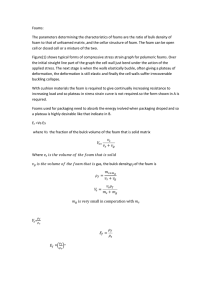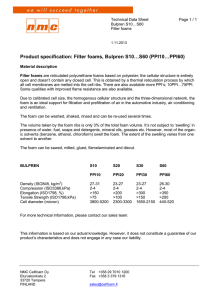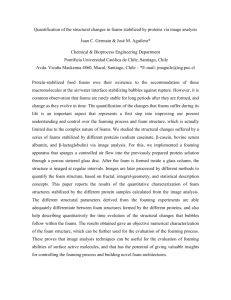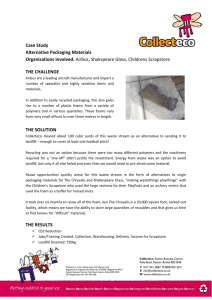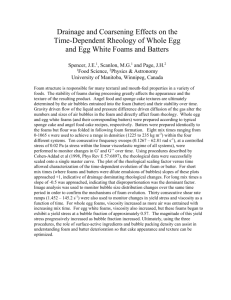Theoretical Model of Viscous Friction inside Steadily Sheared
advertisement
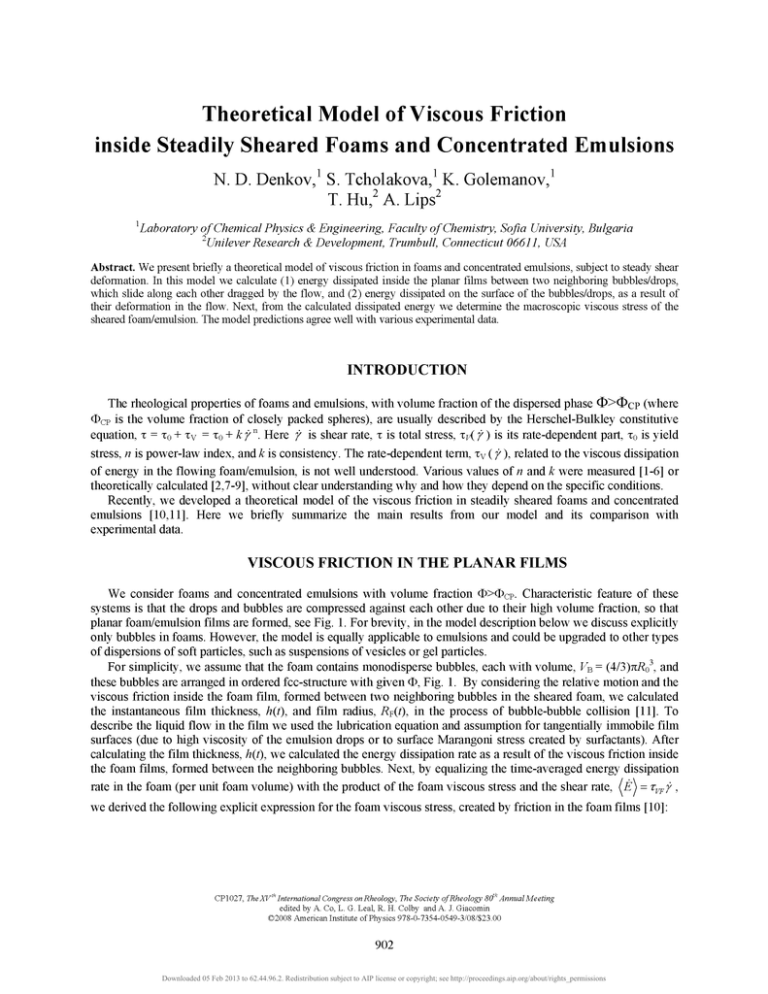
Theoretical Model of Viscous Friction
inside Steadily Sheared Foams and Concentrated Emulsions
N. D. Denkov/ S. Tcholakova/ K. Golemanov/
T. Hu,^ A. Lips^
^Laboratory of Chemical Physics & Engineering, Faculty of Chemistry, Sofia University, Bulgaria
^Unilever Research & Development, Trumbull, Connecticut 06611, USA
Abstract. We present briefly a theoretical model of viscous friction in foams and concentrated emulsions, subject to steady shear
deformation. In this model we calculate (1) energy dissipated inside the planar films between two neighboring bubbles/drops,
which slide along each other dragged by the flow, and (2) energy dissipated on the surface of the bubbles/drops, as a result of
their deformation in the flow. Next, from the calculated dissipated energy we determine the macroscopic viscous stress of the
sheared foam/emulsion. The model predictions agree well with various experimental data.
INTRODUCTION
The rheological properties of foams and emulsions, with volume fraction of the dispersed phase 0 > O c p (where
Ocp is the volume fraction of closely packed spheres), are usually described by the Herschel-Bulkley constitutive
equation, x = TQ + xy = xo + kf^. Here f is shear rate, x is total stress, Xv{j)\s its rate-dependent part, XQ is yield
stress, n is power-law index, and k is consistency. The rate-dependent term, Xy{j), related to the viscous dissipation
of energy in the flowing foam/emulsion, is not well understood. Various values of « and k were measured [1-6] or
theoretically calculated [2,7-9], without clear understanding why and how they depend on the specific conditions.
Recently, we developed a theoretical model of the viscous friction in steadily sheared foams and concentrated
emulsions [10,11]. Here we briefly summarize the main results from our model and its comparison with
experimental data.
VISCOUS FRICTION IN THE PLANAR FILMS
We consider foams and concentrated emulsions with volume fraction 0>Ocp. Characteristic feature of these
systems is that the drops and bubbles are compressed against each other due to their high volume fraction, so that
planar foam/emulsion films are formed, see Fig. 1. For brevity, in the model description below we discuss explicitly
only bubbles in foams. However, the model is equally applicable to emulsions and could be upgraded to other types
of dispersions of soft particles, such as suspensions of vesicles or gel particles.
For simplicity, we assume that the foam contains monodisperse bubbles, each with volume, V-g, = {4/3)nRo^, and
these bubbles are arranged in ordered fcc-structure with given O, Fig. 1. By considering the relative motion and the
viscous friction inside the foam film, formed between two neighboring bubbles in the sheared foam, we calculated
the instantaneous film thickness, h{t), and film radius, i^rCO, in the process of bubble-bubble collision [11]. To
describe the hquid flow in the film we used the lubrication equation and assumption for tangentially immobile film
surfaces (due to high viscosity of the emulsion drops or to surface Marangoni stress created by surfactants). After
calculating the film thickness, h{t), we calculated the energy dissipation rate as a result of the viscous friction inside
the foam films, formed between the neighboring bubbles. Next, by equalizing the time-averaged energy dissipation
rate in the foam (per unit foam volume) with the product of the foam viscous stress and the shear rate, (E) = Typ]>,
we derived the following explicit expression for the foam viscous stress, created by friction in the foam films [10]:
CP1027, TheXV^^ International Congress onRheology, The Society ofRheology 8(f AnnualMeeting
edited by A. Co, L. G. Leal, R. H. Colby and A. J. Giacomm
O2008 American Institute of Physics 978-0-7354-0549-3/08/$23.00
902
Downloaded 05 Feb 2013 to 62.44.96.2. Redistribution subject to AIP license or copyright; see http://proceedings.aip.org/about/rights_permissions
Tvp^0.W6Ca°'''^"'/{\-^f'
(1)
where TVF = xvpRol^ is the respective dimensionless viscous stress. Therefore, the model predicts that the viscous
stress is approximately proportional to Cd'^ (i.e., n « 1/2), as observed experimentally in various studies [1,6,8].
Here Ca = {\xfR(j/a) is capillary number and |a is viscosity of the continuous phase.
8" %
FIGURE. 1. Schematic presentation of the relative motion of neighboring planes of bubbles in sheared foam, and of the process
of fikn formation and thinning between two bubbles, sliding along each other, as a result of the flow drag.
Equation (1) should be used in its range of validity only. Extrapolation to O ^ 1 is not justified, because the
films become very thin at high volume fractions (due to high capillary pressure, which drives the film thinning) and
the surface forces between the film surfaces (which could be expressed via the so-called "disjoining pressure")
become important [11]. Therefore, the upper hmit of using Eq. (1) is set by the comparison of the thickness of
dynamic foam films in sheared foam, h « Ca^'^Ro I 4, with the range of surface forces (typically between 1 and 10
nm) [11]. The lower limit of O is set mainly by the model assumption that the bubbles form planar films while
sliding along each other [11]. The comparison of the model predictions with experimental data (see Fig. 2 below)
shows that Eq. (1) is apphcable at least in the range 0.80 < O < 0.98 .
We developed an extended version of the model, in which we account also for (a) friction in the curved meniscus
regions surrounding the foam films, and (b) effect of surface forces [11]. Friction in the meniscus region around the
films becomes significant only at both high capillary number, ca. Ca > lO""*, and low air volume fraction, O < 0.93.
Surface forces are usually insignificant for steadily sheared foams (except for micrometer-sized bubbles and/or at
very low shear rates), because the dynamic films in these systems are typically thicker than the range of surface
forces. In contrast, for micrometer-sized drops and bubbles, the surface forces could be important, because their
range becomes comparable to the dynamic film thickness. The calculations showed that significant surface forces
lead to stronger dependence of Xy on Ca (viz. 1/2 < « < 1) [11].
Let us compare now the model predictions with the experimental results of Princen and Kiss [1], who measured
the viscous stress, Ty{Ca), for series of concentrated emulsions with different O. The comparison showed a
reasonably good agreement with all experimental data without using adjustable parameters - no difference larger
than 25 % was found (for most of the data < 10 %). As illustration, we show in Fig. 2(a) our theoretical curves and
the experimental data for two of the samples studied in [ 1 ].
Next, we compare the model predictions with experimental results for sheared foams, obtained by us with the
procedure from ref [6]. This comparison also showed reasonably good agreement without adjustable parameter for
foams, stabilized by synthetic surfactants, see as example the lowest curve in Fig. 2(b). Additional results
demonstrating the agreement of Eq. (1) with experimental data, obtained by us with emulsions and foams, are shown
in [11] (again without adjustable parameters).
The upper two curves in Fig. 2(b) could not be explained by Eq. (1), because they evidence much higher overall
energy dissipated in the foams, as compared to the energy dissipated in the respective foam films. Characteristic
feature of these "high-friction" foaming systems is their very high surface dilatational modulus, GD > 100 mN/m,
which is related to the presence of specific cosurfactants (myristic acid and lauric acid) in the foaming solutions.
These results indicate that the surface dissipation of energy on the bubble surface could be important for such
systems. To account for this effect, in Ref [11] we approximated the consecutive expansions and contractions of the
bubble surface in the shear flow (due to the colhsions with the neighboring bubbles) with oscillatory deformation of
amplitude, 55*, and estimated the contribution of the resulting surface dissipation to the total dissipated energy in the
sheared foam. Thus we were able to derive the following expression for the contribution of the surface dissipation of
energy into the total viscous stress [11]:
V, - x , A / c ^ - 9 . 8 7 r ( G „ / a ) 0 ( 5 1 n 5 ) '
(2)
where GLS is surface loss modulus. Taking for estimates O = 0.9 and relative amplitude of surface
expansion/contraction SlnS* = &SISo « 1 %, we obtained for the dimensionless stress Xvs ~ 2.8 x 10"^GLS/CT, which
903
Downloaded 05 Feb 2013 to 62.44.96.2. Redistribution subject to AIP license or copyright; see http://proceedings.aip.org/about/rights_permissions
shows that (a) x^^ could be important, if the surface loss modulus is sufficiently high, and (b) this contribution
should be a weak function of the capillary number, only via possible dependences of 5lnS and GLS on Ca. These
features agree well with the experimental results obtained with foams stabilized by various types of surfactants [11].
As illustration, in Fig. 2(b) we compare theoretically calculated total viscous stress, x^ = x^j, + T^ , with the
experimental data from foam studies, by using an empirical power-law fit of the product entering Eq. (2),
(GLS/CT)(51IIS)^ = Af °^^, where A « 12.6 for foams containing lauric acid (LAc) and A « 21.2 for foams containing
myristic acid (MAc) are constants determined from the fit. These values of ^ are rather reasonable - for 5lnS « 1 %
and f = 0.2 s"\ they give GLS ~ 240 mN/m for LAc and GLS ~ 400 mN/m for MAc, respectively, which was very
close to the experimental values, measured with the foaming solutions by the oscillating drop method [11]. Thus we
can conclude that the viscous dissipation of energy at the bubble surface is responsible for the high viscous stress,
measured with foams containing LAc and MAc as cosurfactants [11] and that n < 111 in such systems.
2.0
O = 0.96 ^ ^ 1.5
-Si
O = 0.90
1.0
,-^'
0.5
^-F-
^"^^^
^^CT
4, = 0.83
^ ^
^
0.0
-0.2
O
•
•
(a)
0.0
0.2
0.4
0.6
0.8
1.0
1.2
1.4
SLES+Betaine
SLES+Betaine+LAc
SLES+Betaine+MAc
10-1
10-1
1.6
10"
101
(b)
102
Shear Rate, s"''
log(r)
FIGURE. 2. Comparison of model predictions (curves) with experimental results (symbols): (a) Oil-in-water emulsions with O =
0.83 and 0.96 [1]; (b) Foams and emulsions stabilized with various surfactants, O = 0.90.
In conclusion, our model predicts that the macroscopic viscous stress is approximately proportional to Ca^'^, i.e.
the power-law index n « 1/2, when the contributions of the surface dissipation of energy and of the disjoining
pressure, acting in the films between the shding bubbles/drops, are both negligible [10]. The model predictions are
compared with experimental data and a very good agreement is found without adjustable parameters for both
emulsions and foams. The account for the surface dissipation of energy on the bubble surfaces predicts n < 111,
whereas the disjoining pressure leads to « > 1/2 [11], thus explaining why different values of n are measured in
various studies.
ACKNOWLEDGMENTS
This work was supported by Unilever R&D, Trumbull, CT, USA.
REFERENCES
1
2
3
4
5
6
7
8
9
10
11
H.M. Princen, A.D. Kiss, J. Colloid Interface Sci. 128, 176-187 (1989).
L.W. Schwartz, H.M. Princen, J. Colloid Interface Sci. 118, 201-211 (1987).
A.M. Kraynik, Ann. Rev. Fluid Mech. 20, 325-357 (1988).
T. G. Mason, J. Bibette, Weitz, D. A., J. Colloid Interface Sci. 179, 439-448 (1996).
R. Hohler, S. Cohen-Addad, J. Phys. Condens. Matter 17, R1041-R1069 (2005) R1041.
N. D. Denkov, V. Subramanian, D. Gurovich, A. Lips, Colloids & Surfaces A 263, 129-145 (2005).
S. Rodts, J. C. Baudez, P. Q.ov&i.oX,Europhys. Lett 69, 636-642 (2005).
A. J. Liuet A.,Phys. Rev. Lett. 76, 3017-3020 (1996).
D. A. Reinelt, A. M. Kraynik, J. Fluid Mech. 215, 431-455 (1990).
N. D. Denkov et al, Phys. Rev. Lett 100, 138301-1-4 (2008).
S. Tcholakova et al., Phys. Rev. E, submitted (2008).
904
Downloaded 05 Feb 2013 to 62.44.96.2. Redistribution subject to AIP license or copyright; see http://proceedings.aip.org/about/rights_permissions
